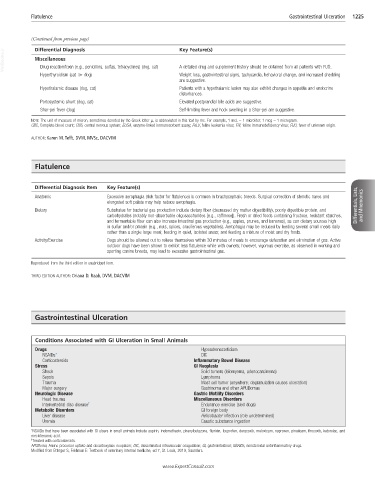Page 2468 - Cote clinical veterinary advisor dogs and cats 4th
P. 2468
Flatulence Gastrointestinal Ulceration 1225
(Continued from previous page)
VetBooks.ir Differential Diagnosis Key Feature(s)
Miscellaneous
Drug reaction/toxin (e.g., penicillins, sulfas, tetracyclines) (dog, cat)
A detailed drug and supplement history should be obtained from all patients with FUO.
Hyperthyroidism (cat ≫ dog) Weight loss, gastrointestinal signs, tachycardia, behavioral change, and increased shedding
are suggestive.
Hypothalamic disease (dog, cat) Patients with a hypothalamic lesion may also exhibit changes in appetite and endocrine
disturbances.
Portosystemic shunt (dog, cat) Elevated postprandial bile acids are suggestive.
Shar-pei fever (dog) Self-limiting fever and hock swelling in a Shar-pei are suggestive.
NOTE: The unit of measure of micron, sometimes denoted by the Greek letter μ, is abbreviated in this text by mc. For example, 1 mcL = 1 microliter; 1 mcg = 1 microgram.
CBC, Complete blood count; CNS, central nervous system; ELISA, enzyme-linked immunosorbent assay; FeLV, feline leukemia virus; FIV, feline immunodeficiency virus; FUO, fever of unknown origin.
AUTHOR: Karen M. Tefft, DVM, MVSc, DACVIM
Flatulence
Differential Diagnosis Item Key Feature(s)
Anatomic Excessive aerophagia (risk factor for flatulence) is common in brachycephalic breeds. Surgical correction of stenotic nares and
elongated soft palate may help reduce aerophagia. Differentials, Lists, Differentials, Lists, and Mnemonics and Mnemonics
Dietary Substrates for bacterial gas production include dietary fiber (decreased dry matter digestibility), poorly digestible protein, and
carbohydrates (notably non-absorbable oligosaccharides [e.g., raffinose]). Fresh or dried foods containing fructose, resistant starches,
and fermentable fiber can also increase intestinal gas production (e.g., apples, prunes, and bananas), as can dietary sources high
in sulfur and/or protein (e.g., nuts, spices, cruciferous vegetables). Aerophagia may be reduced by feeding several small meals daily
rather than a single large meal; feeding in quiet, isolated areas; and feeding a mixture of moist and dry foods.
Activity/Exercise Dogs should be allowed out to relieve themselves within 30 minutes of meals to encourage defecation and elimination of gas. Active
outdoor dogs have been shown to exhibit less flatulence while with owners; however, vigorous exercise, as observed in working and
sporting canine breeds, may lead to excessive gastrointestinal gas.
Reproduced from the third edition in unabridged form.
THIRD EDITION AUTHOR: Oriana D. Raab, DVM, DACVIM
Gastrointestinal Ulceration
Conditions Associated with GI Ulceration in Small Animals
Drugs Hypoadrenocorticism
NSAIDs* DIC
Corticosteroids Inflammatory Bowel Disease
Stress GI Neoplasia
Shock Solid tumors (leiomyoma, adenocarcinoma)
Sepsis Lymphoma
Trauma Mast cell tumor (anywhere; degranulation causes ulceration)
Major surgery Gastrinoma and other APUDomas
Neurologic Disease Gastric Motility Disorders
Head trauma Miscellaneous Disorders
Intervertebral disc disease † Endurance exercise (sled dogs)
Metabolic Disorders GI foreign body
Liver disease Helicobacter infection (role undetermined)
Uremia Caustic substance ingestion
*NSAIDs that have been associated with GI ulcers in small animals include aspirin, indomethacin, phenylbutazone, flunixin, ibuprofen, deracoxib, meloxicam, naproxen, piroxicam, firocoxib, ketorolac, and
meclofenamic acid.
† Treated with corticosteroids.
APUDoma, Amine precursor uptake and decarboxylase neoplasm; DIC, disseminated intravascular coagulation; GI, gastrointestinal; NSAIDs, nonsteroidal antiinflammatory drugs.
Modified from Ettinger S, Feldman E: Textbook of veterinary internal medicine, ed 7, St. Louis, 2010, Saunders.
www .ExpertConsult.com
www.ExpertConsult.com

